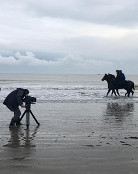Donn's Articles » Irish Derby
Irish Derby
It was disappointing when it was confirmed on Saturday that Workforce would skip this Sunday’s Dubai Duty Free Irish Derby at The Curragh, but it wasn’t wholly surprising. The vibes had been thus even before the dust had fully settled in the winner’s enclosure at Epsom. The Irish Derby might come up too soon, was the general sense emanating from connections, best to aim for the King George instead, best to allow the colt avail of the extra month’s recuperation time that the later target would give him.
It is bad luck for The Curragh. The Epsom Derby winner is the money shot for the Irish Derby. With him, the race holds its head up as a true championship decider, here’s the champ and here are the pretenders who will try to de-throne him; without him the race lacks fizz. And this year more than ever, because of the visual impression of his Epsom win, because of the record-shattering time that he clocked, and possibly because he was Ryan Moore’s first Derby winner, Workforce is the business. He will be conspicuous in his absence on Sunday.
It is the sixth year in a row that the Irish Derby will be run without the Epsom winner, and that is an uncomfortably long time. Also, last year’s renewal was the first wholly indigenous affair since the race was first sponsored, 11 runners, all trained in Ireland, no foreign raider to add a touch of spice, while last year’s winner, Fame And Glory, was the first horse to run to a Timeform rating of 130 or more in winning the race since Alamshar beat Dalakhani in the 2003 thriller.
These days, it is difficult for the top mid-season races to attract all of the good horses all of the time. The racing landscape is in a constant state of flux. The world is smaller than it used to be, and there is a greater number of Group 1 options than there once was for the same number of top class horses. Hence the inevitable thinning.
This is an issue that concerns all of the top class races, not just the Irish Derby. You couldn’t have believed 20 years ago that there would be no three-year-old runner in that mid-season, middle-distance, all-aged classic, the King George VI and Queen Elizabeth Stakes, between 2006 and 2008. Fashions change, opinions are modified, commercial reality bites. If a top 12-furlong three-year-old can demonstrate the speed to win a Group 1 race over 10 furlongs as well, that makes him a much more marketable commodity these days. But even the Eclipse – run over the in-vogue 10-furlong trip – has had an average of just eight runners between 2005 and 2008, and an average of just three three-year-olds.
As well as this, the flat racing season is becoming progressively back-loaded. The races towards the latter end of the season appear to be growing in importance and in stature, and that has to be to the detriment of the early and mid-season. The commercial reality of a Breeders’ Cup victory in November, and the transatlantic interest that it generates, is obvious, while the Arc de Triomphe in October is widely regarded now as the most important middle distance race on the European racing calendar. Andre Fabre once said that you can’t win the King George and the Arc, the implication being that if you are to have a horse at concert pitch for the Arc in October, he should be resting in July. Dylan Thomas disproved that hypothesis in 2007, and Sea The Stars confounded the notion last year when he won six Group 1 races in six months, but it is still a concept that carries much weight among the people who know about these things.
The other thing that has hurt the Irish Derby, strangely, is the alteration in the distance of the French Derby, the Prix du Jockey Club, from a mile and a half to 10 and a half furlongs. If the Epsom Derby winner was absent, or not up to it, there was always the chance that the French Derby winner would make the trip (Montjeu, Dream Well) and, if we were lucky, we got the best from both (Alamshar v Dalakhani).
In the six years since the distance of the Prix du Jockey Club was changed, including this year, the winner has never made the trip to The Curragh. Four of the six winners were essentially milers who were stepping up in trip. More and more, the Grand Prix de Paris is becoming the primary mid-season target for the top French 12-furlong three-year-olds, but the timing of that race relative to the Irish Derby means that participation in one precludes participation in the other.
One noteworthy aspect of the Irish Derby, however, is that it seems to allow longevity. Its recent role of honour reads like a Who’s Who of top middle distance performers: Fame And Glory, Dylan Thomas, Hurricane Run, Alamshar, Galileo, Montjeu, Sinndar. Unlike the Epsom Derby, from which seven of the last 14 winners failed to win again, 12 of the last 13 Irish Derby winners went on to record higher Timeform ratings through their subsequent exploits. While this year’s renewal may be lacking a proven star, therefore, it would be dangerous to under-estimate the potential of the protagonists. It may be that we won’t see the best of this Sunday’s winner until later in his career.
© The Racing Post, 22nd June 2010


 Follow Donn
Follow Donn